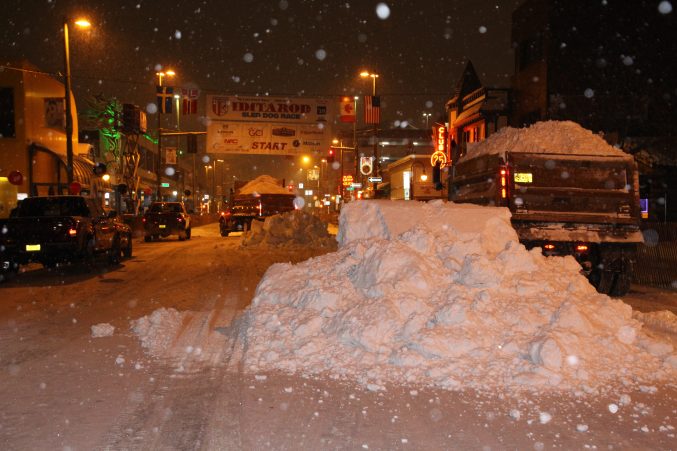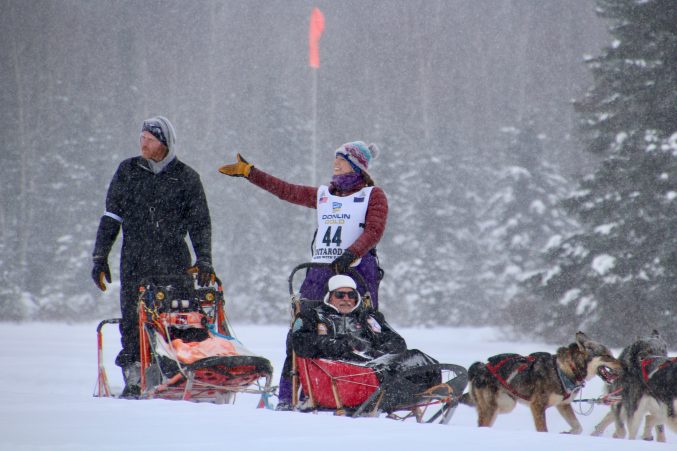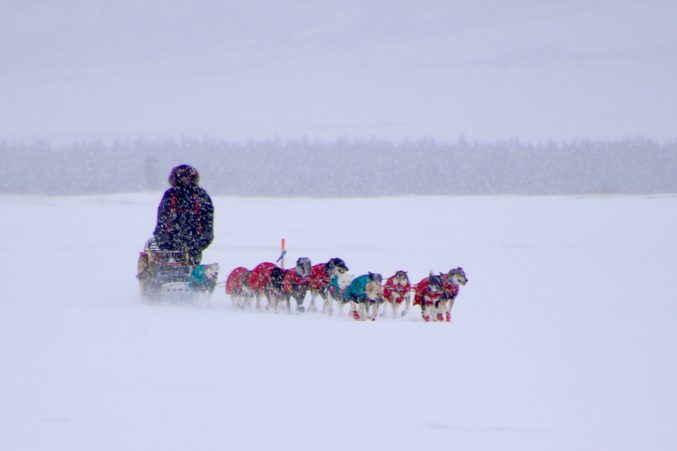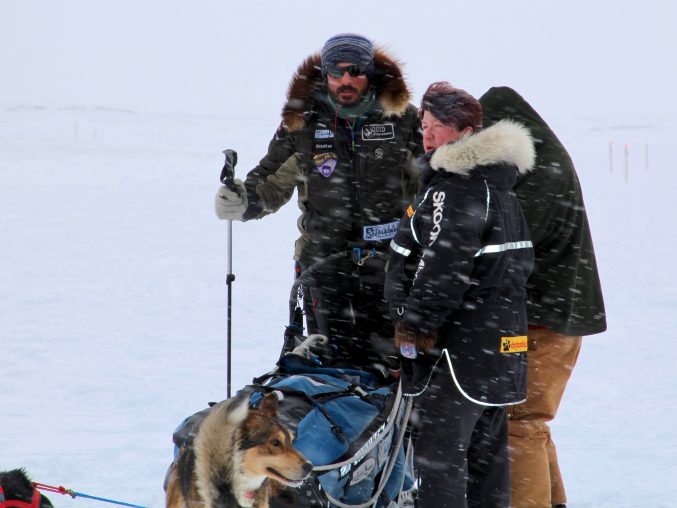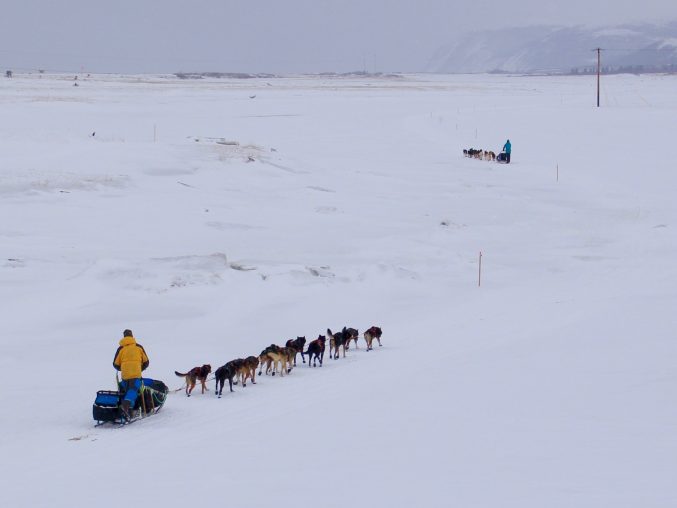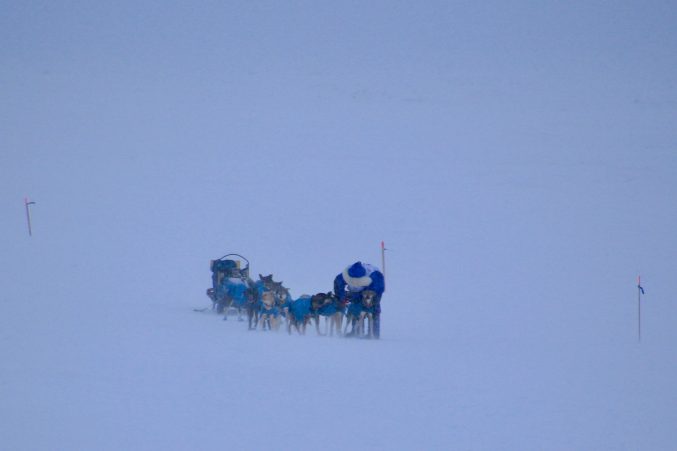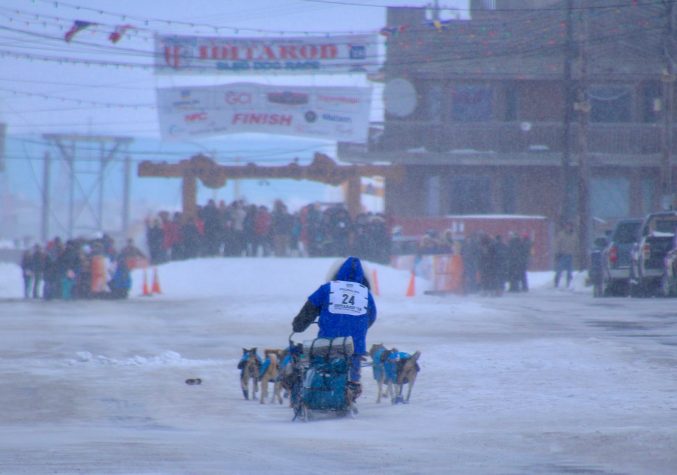Winter storm Wilber has finally passed on through the Dakotas, Minnesota, Wisconsin and Michigan. It snowed steady for almost two days, blanketing optimistic patio furniture and ground that was bare a few days earlier with nearly a foot of snow. Winds were strong but didn’t quite create Norton Sound whiteout conditions. Wilbur added to the 4 inches that fell a few days earlier on the last day of March. It would be accurate to say that March went out like a lion and April came in like a lion. Made me think of all the snow that fell during Iditarod XLVI.
- Anna Stephan Departs for Yentna Station Roadhouse with Snow Falling
JR Iditarod mushers took off in fresh snow on the last Saturday of February. Not only had it snowed all night to cover the trail, but it also continued to snow all day for their 75 mile run to Yentna Station Roadhouse. With the IAF grounded, vets, judges, starter/timer and other race personnel were destined to snowmachine out to Yentna Station. It was a beautiful ride through the snow-laden trees of the woodlands and swamps but being a passenger on a snowmachine is never ideal. The skies cleared overnight and Sunday morning dawned bright and clear at Yentna. The trail was by far faster for the inbound leg of the race.
- Hauling Snow in Falling Snow
Fast forward a week to the Ceremonial start of Iditarod. As snow fell on Friday night, trucks were hauling snow into downtown Anchorage to build the trail for the Ceremonial Start. It snowed all through the night and kept snowing as the teams made the 11-mile run to Campbell Airstrip. It was a winter wonderland that felt quite a bit like the C. S. Lewis story, Narnia.
- Tara Cicatello in the Winter Wonderland of the Ceremonial Start
On Sunday, heading from Anchorage to the restart in Willow fog obscured everything except the car directly in front of the bus. Upon reaching the road sign welcoming spectators to Willow, the grayness became brighter. A quarter mile from the Willow Community Center the fog disappeared letting the sun highlight the hoarfrost-covered trees against a brilliant blue sky. It was a gorgeous day for the spectators but warm for the super excited sled dog athletes. The day of the restart was one of the few days of the race that was blessed with blue sky and sunshine.
- Hoar Frost Dazzles Restart Spectators
Day after day more snow fell on the trail as the teams moved closer to the Alaska Range. Mushers spoke of the sugar holes and the slow going caused by the accumulating snow. Conditions were anything but favorable for the Iditarod Air Force. Getting personnel to checkpoints was delayed by low visibility. Media crews that arrived in Iditarod to report on Joar Leifseth Ulsom’s arrival at the halfway point enjoyed an extended stay when the weather closed in. Insiders, Greg Heister and Bruce Lee, as well as photo guy Jeff Schultz who usually stay with the front of the pack found themselves spending additional nights in Iditarod as the racers moved on toward the Yukon River. Jeff King ended up camping short of Iditarod in whiteout conditions.
- With natural insulation and weather proof guard hair, sled dogs are well equipped for snowy snoozes.
When the teams made the Yukon River, the snow continued and winds picked up. The trail remained slow and challenging. When the Iditarod Air Force couldn’t fly Eagle Island drop bags out of Grayling, race officials advised mushers that Eagle Island would be a hospitality stop, carry enough supplies for the 102 miles to Kaltag. Mushers stepping off the trail on that section of the Yukon River said they were in chest deep snow.
- Magnus Kaltenborn approaches Unalakleet in heavy snow.
Mushers hoped the snow would subside and the trail would harden for the run from Kaltag to Unalakleet and from Unalakleet up the coast. No such luck. There were times in Unalakleet when I had to use manual focus for photos of incoming mushers because my Canon was completely confused as to what to focus on in the heavy snow – the snowflake three feet away or the flake eight feet away, never mind the phantom like form of the musher and dog team twenty feet away.
- Cody Strathe checks in with Karen Ramstead at Unalakleet.
The weather pattern was established and continued over the Blue Berry Hills on the coastal trail from Unalakleet to Shaktoolik and on to Nome. Joar Leifseth Ulsom overtook Nicolas Petit when Petit lost the trail in whiteout conditions between Shaktoolik and Koyuk.
- More snow ahead on the trail to Shaktoolik for Kristi Berington and Andy Pohl.
Would it get better after White Mountain? Ask Jim Lanier and Scott Janssen about that. Once they hit the blowhole, the course of their races changed dramatically. Lanier was blown off course coming out of the blowhole, as fortunately was Janssen’s. Scott tried getting Jim’s team untangled from the driftwood but getting the dogs back on the trail proved impossible. Eventually they called for help. A rescue crew, including Jessie Royer, snow machined out from Safety, locating the two mushers and brought them to Safety.
- Visibility on the Bering Sea is low as Anja Radano approaches Nome.
Even in Nome the snow continued. Commercial airliners were sent back to Anchorage as snow limited visibility so that landing in Nome was out of the question. Some Iditarod fans had stays extended while others had a round trip between Anchorage and Nome without ever setting foot on the ground in Nome. Musher Meredith Mapes’s dad was on an Alaska Air flight that couldn’t land in Nome and returned to Anchorage. Later that evening, he boarded another flight. Would the weather cooperate this time? The flight was able to land in Nome and he made it to the finish line to see Meredith complete her rookie Iditarod.
- Anja Radano on Front Street as a blizzard ramps up.
Comparatively, Wilbur only dropped snow for a couple of days in the mid-west. The mushers of Iditarod XLVI experienced far worse conditions for far longer. Mushers who compete in the Iditarod and the Yukon Quest are a hardy bunch and are prepared for any kind of challenge Mother Nature dishes out. While I’m not complaining about the small inconvenience Wilbur caused here in Wisconsin, I’m ready for spring along with the April showers that bring May flowers. Enjoy these snowy photos!





